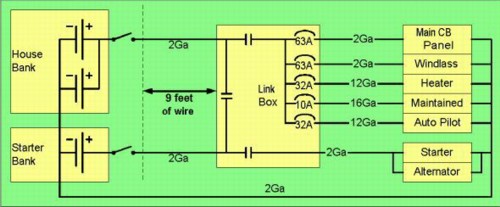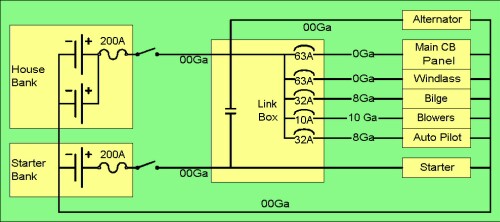Overview
As delivered, the electrical installations on board our Prout Escale were a complete and consistent disaster. Besides habitually installing undersized wiring, Prout Catamarans also managed to omit mandated fuse protection, ignore equipment install instructions, and thus created a number of fire hazards. The wiring diagram for the boat was not followed in actual construction, nor updated to reflect "as installed" versus "as designed". For good measure, Prout Catamarans also sprinkled in some treats like the proprietary (and completely useless) Volt and Ammeter assembly.
Unquestionably the most dangerous aspect of our Prout Escale was that she lacked proper fuse protection. For example, the Link Box is about 9 feet by wire from the battery box. No fuses on the batteries existed, so any short on the way to the Link Box would have been quite disastrous. Inside the Link Box three contactors distributed power across the two main buses in the boat. The starter and alternator shared a circuit which was unfused. The house system was fused in theory - that is until we discovered 18 AWG sense wires stuck into the "upstream" side of the circuit breakers.
Thus, we had 18AWG wires with no fuse protection hooked directly to the battery banks via the contactors. Interestingly, Prout Catamarans also specified mechanical switches at the batteries in addition to the contactors - so the contactors became a useless redundancy, a showroom feature that has no place on a this boat this size.

An overview of our electrical system as installed.
Our charging system was a bitter joke, as hours of charge time did little to nothing to replenish our meager house and starter bank. This was primarily due to the 40 ampere alternator that Perkins included with their engine - good enough to refill the starter bank and little else. But without a proper battery monitoring system it is rather difficult to figure out how effective the alternator and regulator are. It wasn't until we retrofit our Link 20 battery monitoring system that we had a reliable means of telling how full the batteries were.
The battery monitoring system supplied by Prout Catamarans was never operational for long - the only way to figure out how full the batteries were was to apply a voltmeter to them. However, low runtimes on the auxiliary engine and the tiny alternator ensured that whatever batteries were on our Prout Escale would sulphate and die quickly. A further drain on both battery banks were the three contactors in the Link Box.
While they allowed the remote control of power distribution from inside the boat, mechanical switches already existed on the batteries. These simple switches work great and do not draw 40Ah per day to stay "on" like the contactors (40Ah = 15% of battery capacity!).

Since 1996, we have inched our way throughout the boat, retrofitting capable systems to replace what Prout Catamarans had installed, and discovering many more "treats" than we imagined possible. We started by replacing the main wiring runs followed by a charging system retrofit. We removed two contactors from the Link Box, added fuse protection to the battery banks, and simplified the system where possible. Once the infrastructure was under control we installed AGM batteries - otherwise we would have wasted them.
More wiring throughout the boat was replaced in 2001 and 2002. Our new furnace installation called for direct connections to the battery so we have reconfigured the 32A circuit breaker for the heater to run the bilge pumps instead. We have retrofitted blowers to supply the engine with the right amount of air and re-dedicated the "Maintained" circuit breaker to serve them. We continue to replace wiring to this day as time and access permits. At this point, all primary circuits (shown above) and most secondary circuits (the ones that leave the circuit breaker panel for example) have been replaced.
Some OEM-installed circuits remain, usually tertiary circuits that feed off a secondary circuit. These consist mainly of lighting and electrical outlet circuits that are exceedingly difficult to replace. Prout Catamarans had a curious penchant for integrating wiring into the structures it built, putting it behind glued panels, for example. Thus, it is downright impossible to remove wiring in many areas without disassembling the boat structure. We've elected to leave many of these low-amperage circuits as is because the expected return on our work effort would be so low. Besides, now that they are properly fused, they no longer pose the same fire hazard as they did before.
However, the first task was to sit down and actually document what was on board and what was not. Hence, I created a new and complete wiring diagram from scratch. This drawing incorporates every circuit on board - engine, its controls, charging system, etc. When it is finished, no wire will be left out. My drawing was based on the wishful thinking called "electrical diagram" that Prout Catamarans had delivered with the boat. From there I took dives into various areas of the boat to verify and correct the drawing based on what I found.
This drawing is by no means complete yet. But it captures the most important systems and the changes we made to them. For example, the Ample Power charging system required some rewiring of the engine and its controls. Furthermore, the drawing allows us to identify suspect areas like the Link Box, come up with a simpler solution on paper, then implement it in the Escale. Unlike Prout Catamarans, I also document the negative wiring runs. For some reason the folks at Prout seem to think that as long as you provide positive conductor information that the rest will take care of itself. As expected, we found a number of "bugs" in the return section of our electrical systems which explained erratic instrument behavior such as the GPS cutting out.
Best Estimate for Time Required:
| Create drawing to properly document entire wiring system | 80 hours |
|---|
| Total | 80 hours |
|---|

